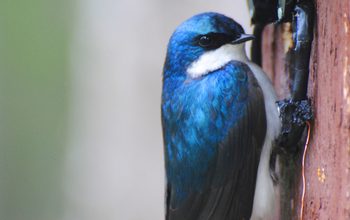Multimedia Gallery
Tree swallows and stress
A tree swallow returns to its nest box to incubate eggs. Researchers surrounded the nest’s opening with an antenna that was coupled with a tracking tag on the bird. Using this design on each nest box and bird, researchers recorded more than 177,000 feeding visits for 63 females in 2015.
More about this image
Two recent studies of tree swallows use an innovative study design to uncover long-term consequences of passing but major stressful events. Both studies provide information on how major stressful events have lasting effects and why some individuals are more susceptible to those impacts than others.
In the first study, researchers developed a new method for manipulating hormone levels in free-living birds. They dissolved a stress hormone (glucocorticoid) in a gel and put it on eggs in tree swallow nests. The females -- the only ones who incubate -- absorbed the hormone through their skin. They were given five separate doses for an hour each early in their reproductive periods. After absorbing the hormone, females fed their offspring at lower rates once they hatched, which led to much smaller offspring compared to two types of controls (one type with gel but no hormone on an egg and the other undisturbed). The smaller offspring in turn had lower survival rates.
"The take-home message here," said Maren Vitousek, assistant professor in the Department of Ecology and Evolutionary Biology at Cornell University, "is that the hormones that birds would be exposed to if they had a short-term stressor do have these long-term effects."
The researchers also found that birds exposed to higher doses of glucocorticoid were more likely to endure lingering impacts. This result suggests that individuals who naturally mount a stronger hormonal response to brief challenges may be at greater risk of suffering from lingering effects of stress, Vitousek said.
For the second study, which examined conditions that predict susceptibility to stress and why some individuals cope with stress better than others, the researchers captured birds and measured baseline stress hormone levels; how high they increased from the stress of capture; and how quickly they returned to normal levels. The birds were then released and exposed to glucocorticoid on eggs, using the same protocol as the previous study. After these birds absorbed the hormone, the researchers measured how fast they recovered to their baseline hormone levels.
There was a lot of variation among the birds but a pattern revealed birds that were better able to turn off that initial stress response to capture also returned to baseline levels faster, following glucocorticoid exposure.
"Individuals that are more naturally stress resilient are those that are better able to turn off this response to begin with," Vitousek said.
[Both studies were funded by the National Science Foundation (grants IOS 14-57251 and DEB 07-17021).]
Read more about this research in the Cornell news story Tree swallow study: Brief stressors have long-term effects. (Date image taken: June 2017; date originally posted to NSF Multimedia Gallery: April 12, 2019)
Credit: Maren Vitousek, Cornell University
Images and other media in the National Science Foundation Multimedia Gallery are available for use in print and electronic material by NSF employees, members of the media, university staff, teachers and the general public. All media in the gallery are intended for personal, educational and nonprofit/non-commercial use only.
Images credited to the National Science Foundation, a federal agency, are in the public domain. The images were created by employees of the United States Government as part of their official duties or prepared by contractors as "works for hire" for NSF. You may freely use NSF-credited images and, at your discretion, credit NSF with a "Courtesy: National Science Foundation" notation.
Additional information about general usage can be found in Conditions.
Also Available:
Download the high-resolution JPG version of the image. (3.6 MB)
Use your mouse to right-click (Mac users may need to Ctrl-click) the link above and choose the option that will save the file or target to your computer.

